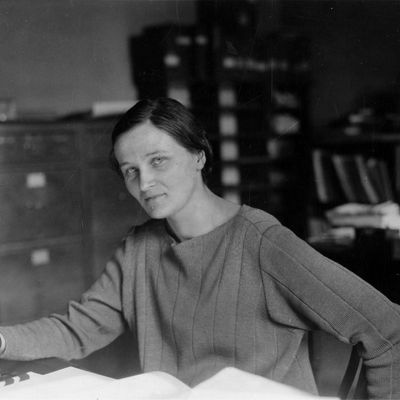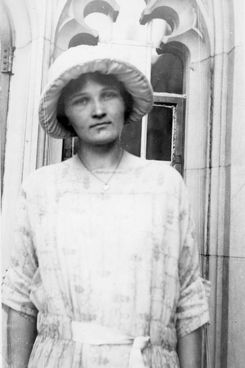
Astronomers recently used large radio telescopes in Germany and Australia to map the distribution of hydrogen gas throughout our galaxy, the Milky Way. Meanwhile, another team of researchers is looking back in time to track the so-called “hydrogen epoch” in early cosmic history, when the first celestial lights in the universe turned on. Although all astronomers now recognize hydrogen as the most abundant element in space and the main component of stars and galaxies, that fact was slow to dawn.
In 1924, when astronomy student Cecilia Payne discovered that stars consisted mostly of hydrogen, the idea seemed ludicrous. Even those who praised the young woman’s research were shocked by her finding. Miss Payne herself struggled to believe it, yet the results of her studies surely pointed that way. Her mentor at the Harvard College Observatory urged caution. On her behalf, he sent her draft report to the foremost authority on stellar composition — to Henry Norris Russell of Princeton University.
Although the presence of hydrogen in the sun and other stars had been known since the 1860s, when chemical analysis at a distance first became possible, no one expected the great abundance of hydrogen claimed by Miss Payne. Stars contained numerous familiar elements, such as oxygen, silicon, aluminum, and iron. Given that the list of stellar ingredients matched the makeup of the Earth, it seemed likely that the same recipe proportions should prevail. Only a pinch of hydrogen was required in the heavens, not a preponderance of it.
Russell at Princeton read Miss Payne’s paper, then returned it with honest compliments on her approach and only a lone complaint: “It is clearly impossible,” he wrote her on January 14, 1925, “that hydrogen should be a million times more abundant than the metals.”
Miss Payne had arrived at the Harvard Observatory in Cambridge, Massachusetts, in the autumn of 1923, all the way from Cambridge, England. Her professors at the university there had warned her she would never realize her career dreams in the country of her birth. Across the Atlantic at Harvard, however, where a long line of women had worked as observatory assistants, she might aspire to a brighter future. Heartened, she applied for and won a Harvard fellowship specifically earmarked for female college graduates in pursuit of an advanced degree in astronomy. She was only the second person in this new program, and quickly befriended her fellow candidate, Adelaide Ames, a recent alumna of Vassar College. They became known around the observatory as “the heavenly twins.”
In addition to a niche for women, Harvard offered Miss Payne its unique collection of several hundred thousand glass photographs of the night sky, taken over a period of 40 years, through telescopes in the southern hemisphere as well as the northern. Many of these glass images portrayed the stars as points of light, while others splayed starlight into strips, or spectra, marked by naturally occurring lines that revealed the constituent elements.
“What if I should break one of the plates?” she worried aloud to the observatory director, Harlow Shapley. In that case, he assured her with his typical humor, she could keep the shattered pieces of glass.

Miss Payne applied the new theories of atomic structure and quantum physics to her analysis of stellar spectra. No one at the Harvard Observatory had yet attempted such an investigation, as no one there possessed the necessary background. She, in contrast, had learned the complex architecture of the “Bohr atom” directly from Niels Bohr, winner of the 1922 Nobel Prize in physics. She had also followed the work of Indian physicist Meg Nad Saha of Calcutta, the first person to link the atom to the stars. Saha maintained that the line patterns in stellar spectra differed according to the temperatures of the stars. The hotter the star, the more readily the electrons of its atoms leaped to higher orbits. With sufficient heat, the outermost electrons broke free, leaving behind positively charged ions with altered spectral signatures.
Building on Saha’s base, with insights gained from a couple of her professors in England, Miss Payne selected specific spectral lines to examine. Then she estimated their intensities in hundreds of stellar spectra. Element by element she gauged, plotted, and calculated her way through the plates to take the temperatures of the stars.
She was about to submit a preliminary report to Nature, under the name C. H. Payne, when Shapley challenged her by asking, “Are you ashamed of being a woman?” The question induced her to change her author identity to Cecilia H. (for Helena) Payne.
Miss Payne’s fellowship at Harvard provided funding for only one academic year, 1923 to 1924, or just enough time for her to complete a masters degree. Shapley wanted her to stay on — to continue her novel research and earn the university’s very first doctoral degree in astronomy. A $1,000 foreign-student scholarship from the American Association of University Women won her the necessary second year in residence.

While teasing out the relative quantities of elements in stars of different temperature ranges, Miss Payne came to appreciate how hydrogen and helium, the two lightest elements, dwarfed every other component. This outcome defied her expectations. It defied all expectations.
Miss Payne had exercised great care in her methodology, but after both Shapley and Russell balked at her numbers, she dared not gainsay their authority. Writing her dissertation in the spring of 1925, she allowed that her percentages of hydrogen and helium were “improbably high,” and therefore “almost certainly not real.” In a discipline as young as the physical chemistry of stars, anomalous findings were no cause for shame. Rather, they indicated pockets of mystery to be further investigated and explained. Shapley proudly published Miss Payne’s thesis, Russell lauded it, and Radcliffe College of Harvard University awarded her a Ph.D.
The hydrogen question, however, still begged for resolution. Russell took it up himself and devoted the next four years to it. More than once during that time he concluded a series of calculations that suggested a predominance of hydrogen in the sun and other stars. Each time this happened he rejected the results as spurious. When he could reject them no longer, he wrote a lengthy paper, “On the Composition of the Sun’s Atmosphere,” for the July 1929 issue of the Astrophysical Journal. Here, in the premier publication of his field, the dean of American astronomy at last agreed with Miss Payne and cited her 1925 study. Making no mention of his own early disbelief, he concluded for the record that the great abundance of hydrogen “can hardly be doubted.”
The perceived constitution of the universe inverted. The omnipresence of hydrogen and helium, first intuited by Cecilia Payne, reduced all other cosmic components to chaff. What had long been presumed minimal was now proved plentiful by Russell’s deep analysis: The lightest, most immaterial elements reigned supreme.
Miss Payne remained at the Harvard Observatory for the rest of her working life, first as a post-doctoral fellow, later as a full-fledged astronomer, then a tenured professor, and for a time the chair of the university’s astronomy department. In her memoir she said of Russell, “I respected and feared him, but I could feel no affection for him.”
Dava Sobel is a former science reporter for the New York Times and the author of five books, including the New York Times best-sellers Longitude, Galileo’s Daughter, and The Planets. In addition to having an asteroid named for her (#30935), Sobel is the recipient of the National Science Board’s prestigious Individual Public Service Award and the Boston Museum of Science’s Bradford Washburn Award, among many others.
Her latest book, The Glass Universe: How the Ladies of the Harvard Observatory Took the Measure of the Stars, is out December 6 from Viking.